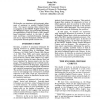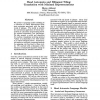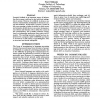ACL
1994
14 years 24 days ago
1994
Considering the speed in which humans resolve syntactic ambiguity, and the overwhelming evidence that syntactic ambiguity is resolved through selection of the analysis whose inter...
ACL
1996
14 years 24 days ago
1996
In this paper 1 we present a new parsing algorithm for linear indexed grammars (LIGs) in the same spirit as the one described in (Vijay-Shanker and Weir, 1993) for tree adjoining ...
ACL
1994
14 years 24 days ago
1994
ACL
1996
14 years 24 days ago
1996
We use a statistical method to select the most probable structure or parse for a given sentence. It takes as input the dependency structures generated for the sentence by a depend...
ACL
1994
14 years 24 days ago
1994
Finite-state transducers give efficient representations of many Natural Language phenomena. They allow to account for complex lexicon restrictions encountered, without involving t...
ACL
1996
14 years 24 days ago
1996
\Prose rhythm" is a widely observed but scarcely quanti ed phenomenon. We describe an information-theoretic model for measuring the regularity of lexical stress in English te...
ACL
1994
14 years 24 days ago
1994
ACL
1996
14 years 24 days ago
1996
We present a language model consisting of a collection of costed bidirectional finite state automata associated with the head words of phrases. The model is suitable for increment...
ACL
1994
14 years 24 days ago
1994
Semantic feedback is an important source of information that a parser could use to deal with local ambiguities in syntax. However, it is difficult to devise a systematic communica...
ACL
1996
14 years 24 days ago
1996
This paper describes a system that leads us to believe in the feasibility of constructing natural spoken dialogue systems in task-oriented domains. It specifically addresses the i...




